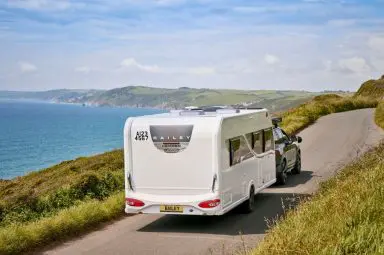Best campsites next to train stations: Scenic UK stays
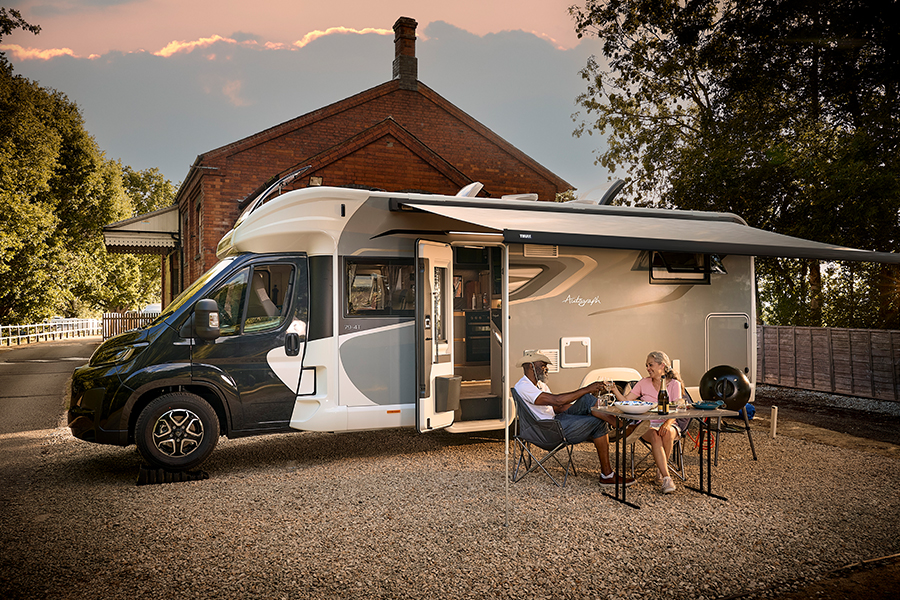
But when you bring your own motorhome along for the ride, you get the same scenery with the ability to also break free from the rails. Following the rails by road means you can settle in when a place catches your eye and enjoy it all at your own pace.
For anyone who likes to plan carefully, but also values the comfort of changing plans when the mood strikes, these routes give you the best of both worlds. Read on to find the best campsites next to train stations for a perfect holiday that allows you to find the beauty of Britain’s classic railway lines.
So, why should you follow the rails by road?
Some people may find it a strange foundation to theme your holiday upon, but it actually makes a lot of sense, especially if you’re a lover of classic steam trains.
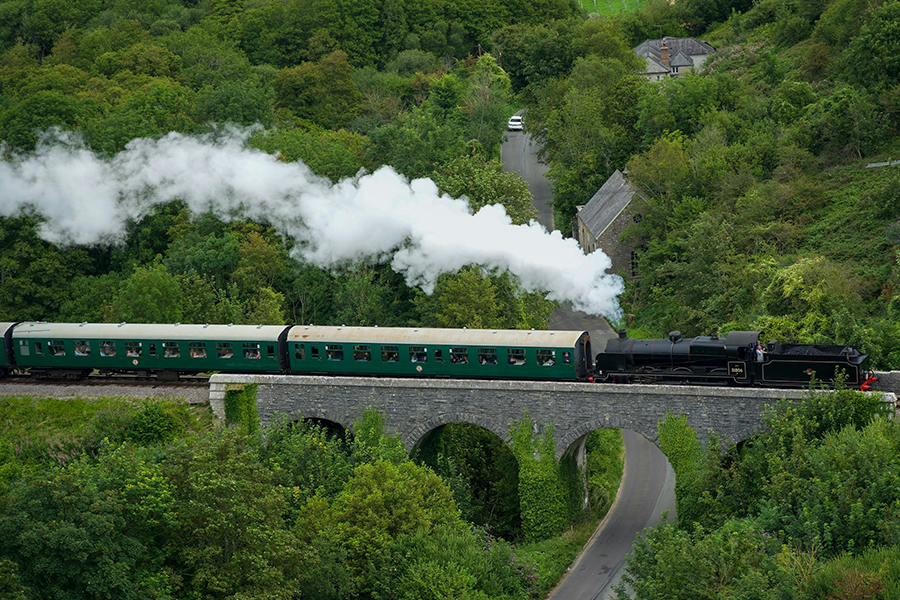
Railways were laid out to take in the most scenic parts of the landscape. So, you’ll find them winding alongside rivers, often hugging the coastline and finding the best routes through mountains and valleys. Therefore, following those lines by motorhome lets you see the same countryside, but all without worrying about things like timetables and luggage restrictions.
And for history lovers, many towns along the way grew up around the stations themselves. Exploring them by road means you can uncover the railway’s heritage, then return to the comfort of your van at the end of the day.
The best UK motorhome routes that shadow famous train lines
1. The Settle–Carlisle Railway (Yorkshire Dales to Cumbria)
Opened in 1876, this stretch of track became famous for its engineering challenges and its dramatic views, especially at Ribblehead, where the viaduct dominates the valley. It’s a route that feels timeless, threading through the Pennines and remote stations that look almost untouched since the Victorian era.
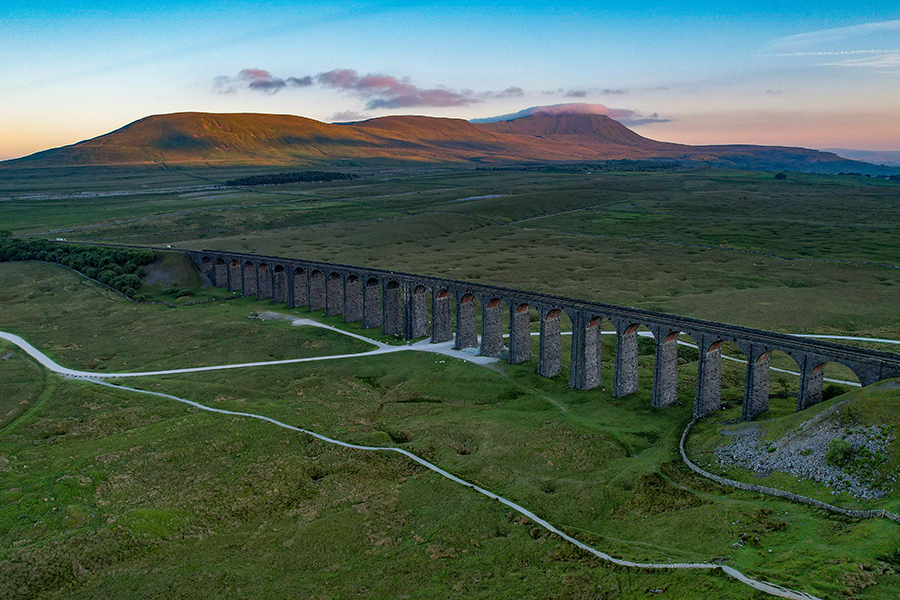
Not to be missed
- The Ribblehead Viaduct: This is the centrepiece, and the good news is that it’s easy to reach: park up at Ribblehead Station’s car park and it’s a flat ten-minute walk along a gravel path to the arches. The old Settle Signal Box still opens its doors on selected weekends (although, check ahead if you’d like a peek inside).
- Dent: If you’re curious about England’s highest station, Dent is well worth the detour, though parking is tight.
- Sedbergh: A more relaxed option is to overnight at Sedbergh and head in early the next morning.
- Hawes: For a more leisurely stop, Hawes has a large motorhome-friendly car park next to the Wensleydale Creamery, where you can sample the local cheese before wandering into town.
Best campsites
Hawes Caravan and Motorhome Club Site makes a great base, with riverside pitches and the town just a short stroll away.
If you’d rather be closer to the northern end of the line, Teesdale Barnard Castle Club Site is a peaceful spot surrounded by countryside, ideal for a slower exploration of the Dales and beyond.
2. The West Highland Line (Glasgow to Fort William/Mallaig)
Built in the late 19th century, the West Highland Line has a worldwide reputation for its scenery.
You’ll pass sea lochs and cross the Glenfinnan Viaduct, which is now instantly recognisable to Harry Potter fans. It’s still partly steam-operated too, with the Jacobite train running through summer.
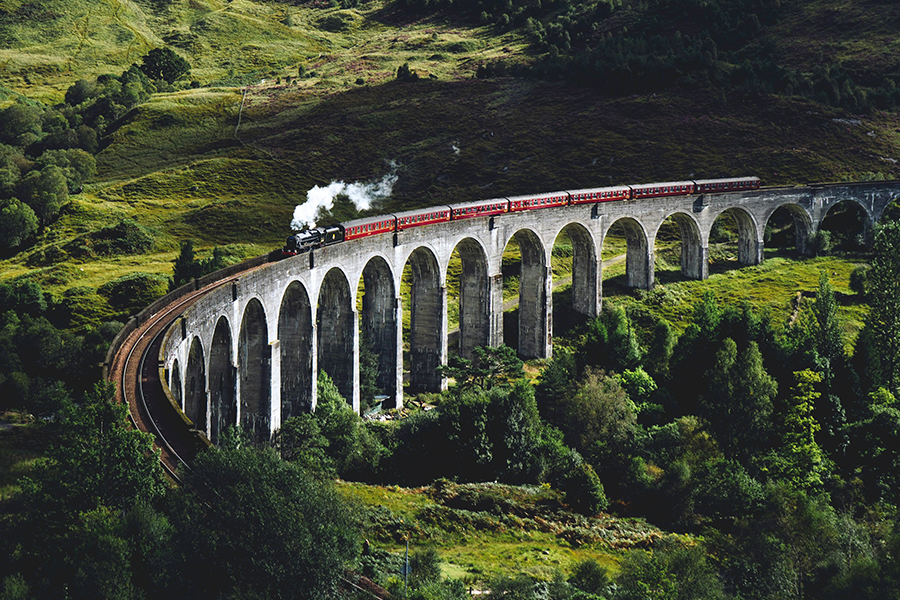
Highlights
Glenfinnan Viaduct: To see the Glenfinnan Viaduct without the crowds, stay overnight at the Glenfinnan Station Museum’s small camper stop. From there, it’s only a five-minute walk to the viewpoint, so you can be in place before the tour buses arrive.
- Ben Nevis: If you’d like quieter walking with railway views, the North Face car park near Ben Nevis gives you easy access to woodland trails.
- Arisaig: For a coastal stop, Arisaig is a treat. You can park up right by the harbour and watch the trains cross the sands as the tide shifts.
- Isle of Skye: If you’re carrying on to Skye, remember to book the Mallaig–Armadale ferry well in advance in summer, as spaces for motorhomes go quickly.
Best campsites
Bunree Caravan and Motorhome Club Site is hard to beat, with lochside pitches that give you sweeping Highland views.
Alternatively, Glen Nevis Camping and Caravanning Club Site sits at the foot of Ben Nevis itself, with good facilities and plenty of space, just minutes from Fort William.
3. The Cambrian Line (Shrewsbury to Aberystwyth/Pwllheli)
This mid-19th-century line stretches from the border town of Shrewsbury to the Welsh coast, meandering through estuaries, beaches and mountains. It’s a slower journey than some, but that’s the charm, because it makes it ideal for coastal stops.
Highlights
- Aberystwyth: In Aberystwyth, motorhomes can park at the south promenade by the marina, giving you a flat stroll into town or an easy hop onto the cliff railway up Constitution Hill.
- Harlech’s castle: This dominates the coast, but the on-site parking is small, so head for the long-stay beach car park: it’s a level ten-minute walk to the castle gates.
- Barmouth: Barmouth’s iconic bridge, shared by trains and pedestrians, has a toll of just £1 each way; worth keeping some coins handy as contactless isn’t always reliable here.
- Porthmadog: For a handy midway break, the heritage railway station café has plenty of space for parking and makes a good lunch stop even if you don’t ride the train.
Best campsites
Min y Don Caravan and Motorhome Club Site sits right at the foot of Harlech Castle and backs directly onto the beach, giving you the best of both worlds.
Further inland, Bala Camping and Caravanning Club Site is a peaceful base, especially if you’re exploring the eastern end of the line and want easy access to the lake as well as the hills.
4. The Cornish Main Line (Plymouth to Penzance)
Linking London with the far west, this line became famous for its dramatic Dawlish sea wall section, where trains run just metres from the waves.
It remains a vital mainline route, but for motorhome travellers it offers the perfect excuse to combine seaside towns with fishing villages and cliff-top walks.
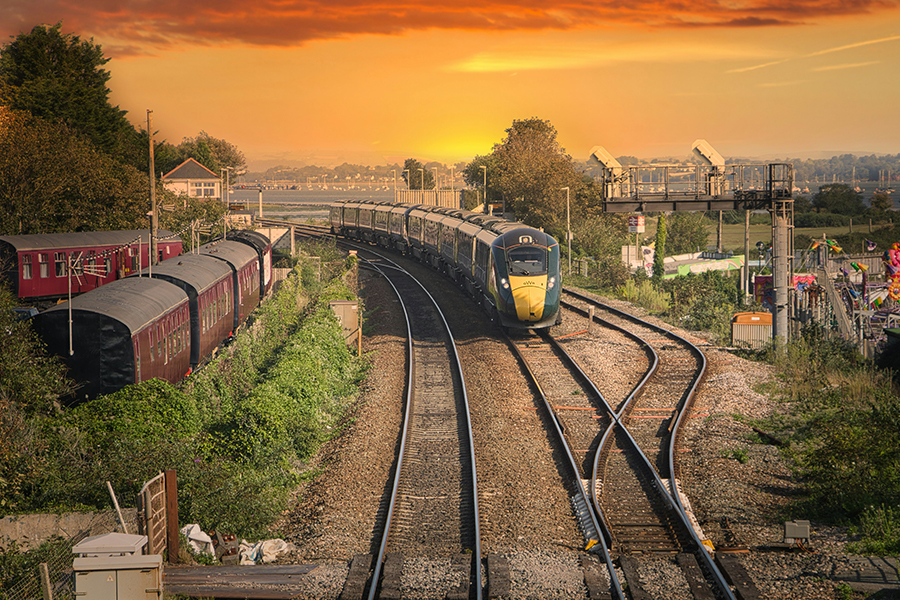
Highlights
- Dawlish: At Dawlish, there’s a seafront car park only a short walk from the railway itself, so you don’t need to trek far for a front-row view of trains against the sea. If you’d like to see the St Ives branch line, avoid the narrow streets by parking at St Erth park & ride, which has motorhome bays and gives you the same coastal views from the train into town.
- Lostwithiel: This a quieter stop, with easy riverside parking just five minutes’ walk from the antiques shops and cafés in the centre.
- Penzance: At the western end, Penzance harbour offers overnight options within walking distance of the promenade and the station, as well as ferries to St Michael’s Mount.
Best campsites
Carnon Downs Caravan and Motorhome Club Site, near Truro, makes a central base for exploring both coasts and offers well-kept facilities.
For the far west, Sennen Cove Camping and Caravanning Club Site is a welcoming stop near Land’s End, perfect for visiting Penzance and the surrounding coastline.
5. The Highland Main Line (Perth to Inverness)
Running from Perth up through the Cairngorms, this line was built in stages from 1863 and remains a showcase of Scotland’s engineering heritage. It links the whisky country with pine forests and mountain views, blending history with natural beauty.
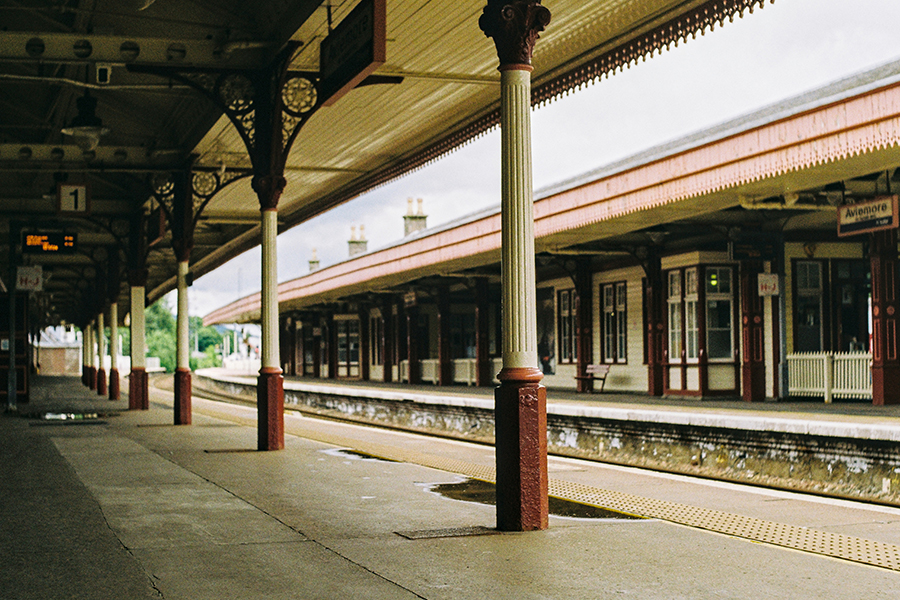
Highlights
- Pitlochry: Pitlochry makes a good first stop, with the Atholl Road car park offering motorhome spaces just an eight-minute walk into town and to the station.
- Aviemore: Aviemore is another highlight, where the Old Station Square parking gives you easy access to the Strathspey Railway.
- Dalwhinnie Distillery: If whisky’s on your itinerary, Dalwhinnie Distillery is directly off the A9 and has a spacious car park that’s easy to navigate.
- Loch an Eilein: For a more outdoorsy stop, Loch an Eilein near Rothiemurchus has motorhome-friendly parking with forest trails that begin right by the car park.
Best campsites
Blair Atholl Caravan and Motorhome Site is a favourite for its riverside pitches and proximity to Pitlochry.
Further north, Speyside Camping and Caravanning Club Site offers a peaceful, wooded setting that puts you right in the heart of whisky country.
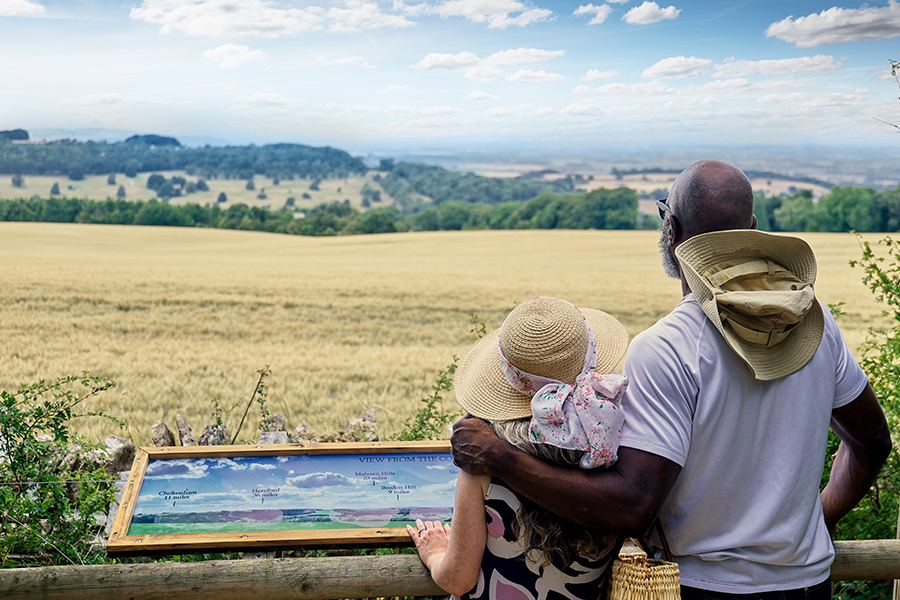
Overall tips for Tailored Retreats travellers
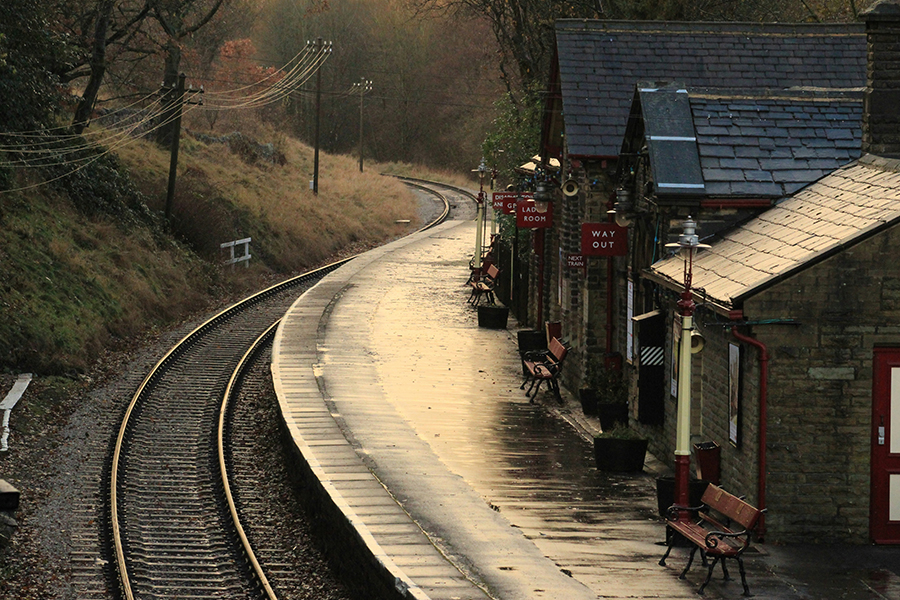
- Look up station parking rules before you arrive: Some heritage stations welcome motorhomes for daytime parking, others don’t, and the last thing you want is to arrive and find a height barrier. So have a quick check ahead to save any hassle.
- Mix road and rail for the best of both: Even if you’re shadowing a line by road, try taking the train for one section. It gives you the chance to relax and see the views from the carriage, then return to your van later that day.
- Plan your food stops as carefully as your pitches: Rural stations and smaller towns don’t always have late-opening shops. Keeping a well-stocked fridge, or planning meals around market days, can make life much easier.
- Travel slightly off-season if you can: Spring and autumn bring quieter campsites and emptier trains, but they also give you better light for photography and fewer midges in Scotland. Those small differences make a big impact on the overall trip.
- Keep an eye out for rail heritage extras: Many stations are attractions in themselves with things like small museums, cafés (sometimes in restored carriages) and local walks that aren’t well signposted, so keep a look out.
Ready to follow the rails?
The beauty of shadowing Britain’s great railway lines is that you don’t need to give up comfort or flexibility to do it. You’ll enjoy the same views as the trains, with the freedom to stop, settle in, and plan your days exactly as you like.
With a Bailey of Bristol motorhome, you’ll have layouts designed for comfort on longer trips, and the reassurance that when the scenery changes outside, home feels just the same inside.
Wherever the tracks might lead you, you can follow them at your own pace.
Inspired to follow the rails by road? Head to our blog for more campsite tips and holiday inspiration to help you plan your next adventure.
Latest news & events
See all news & eventsCaravan Tech Annual Open Weekend
Caravan Tech, Merriments, Hawkhurst Road, Hurst Green, East Sussex

